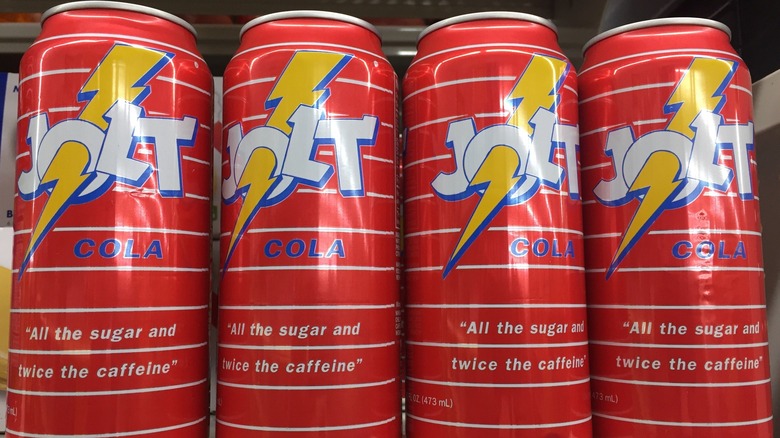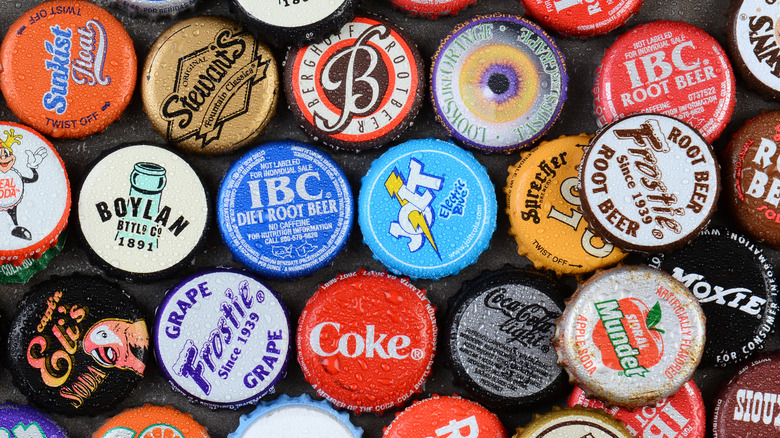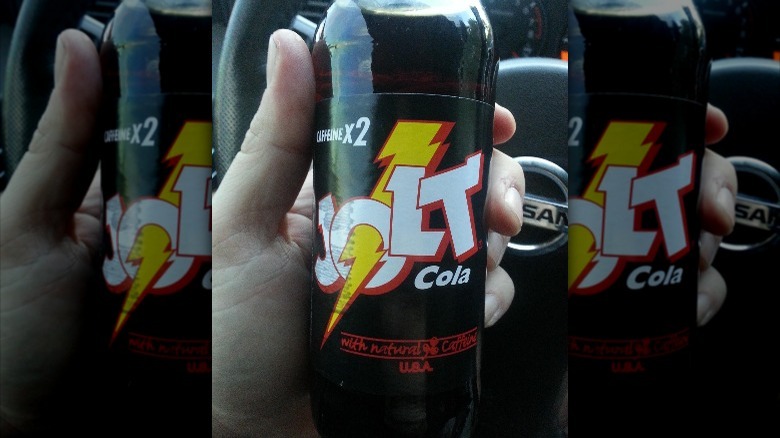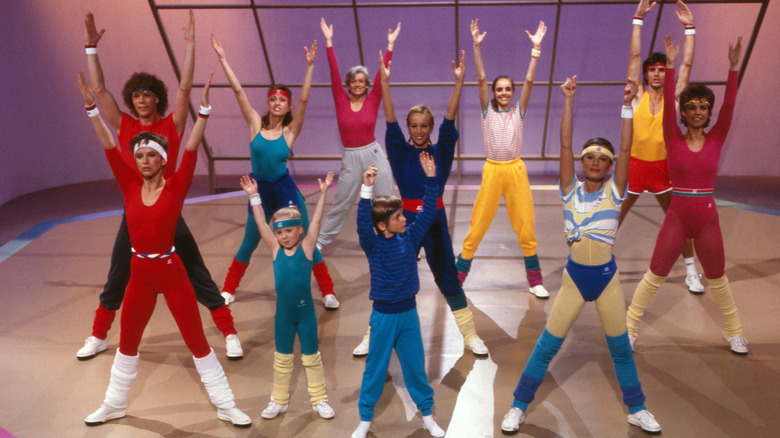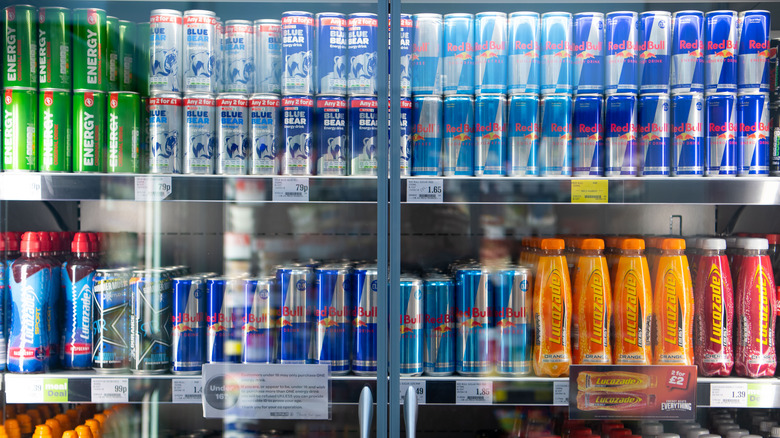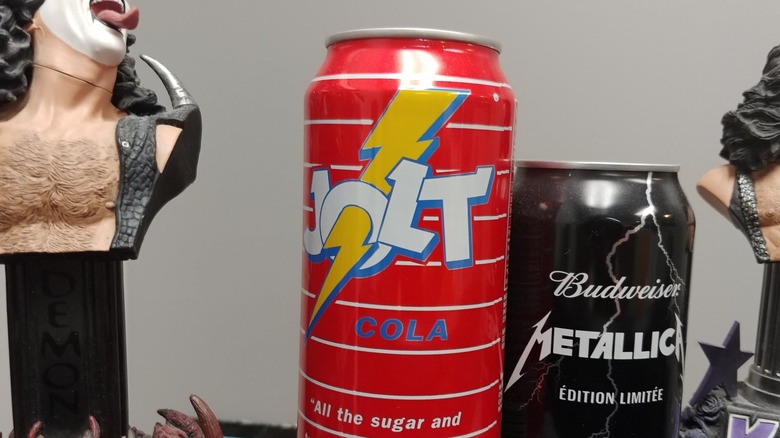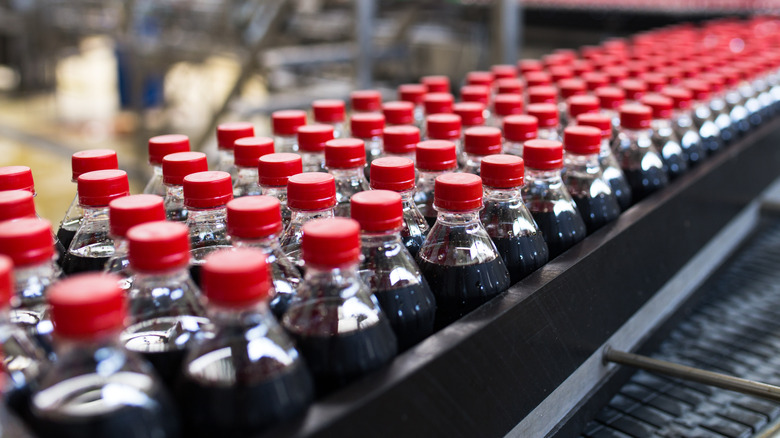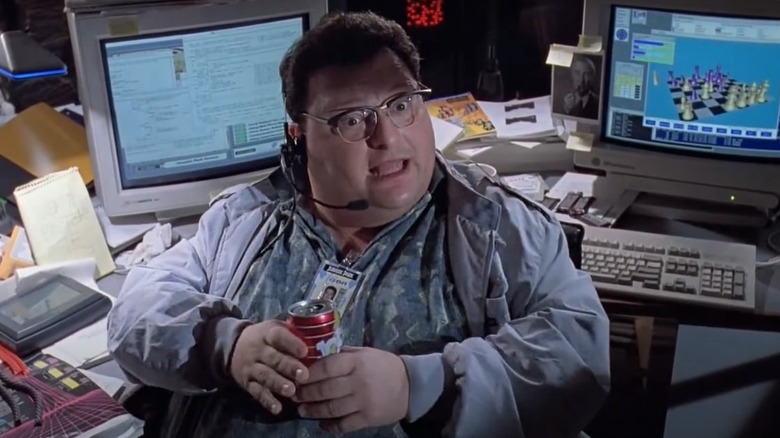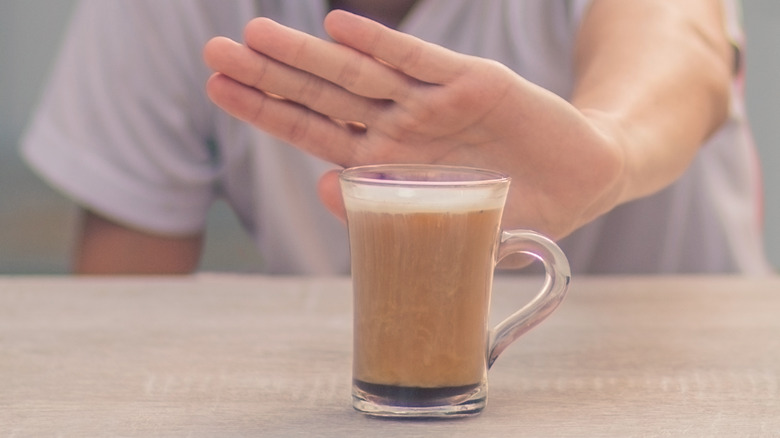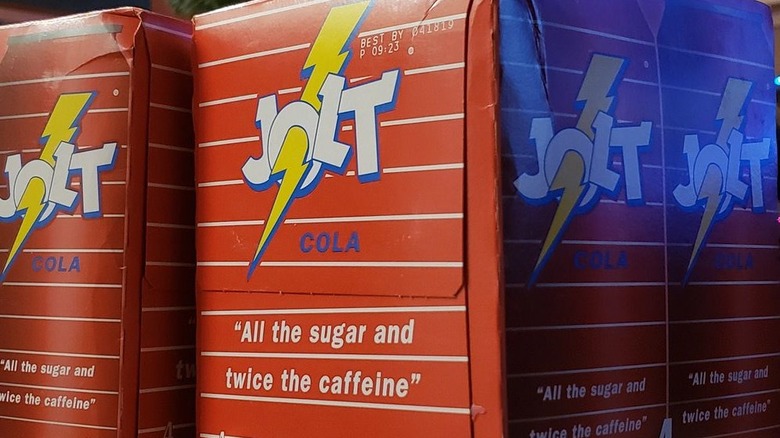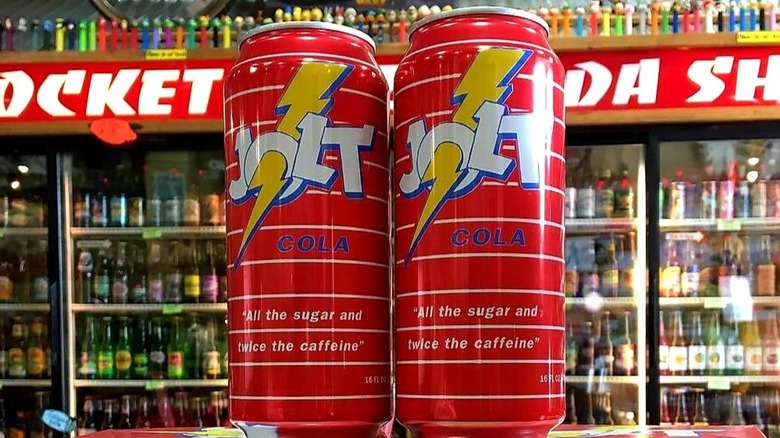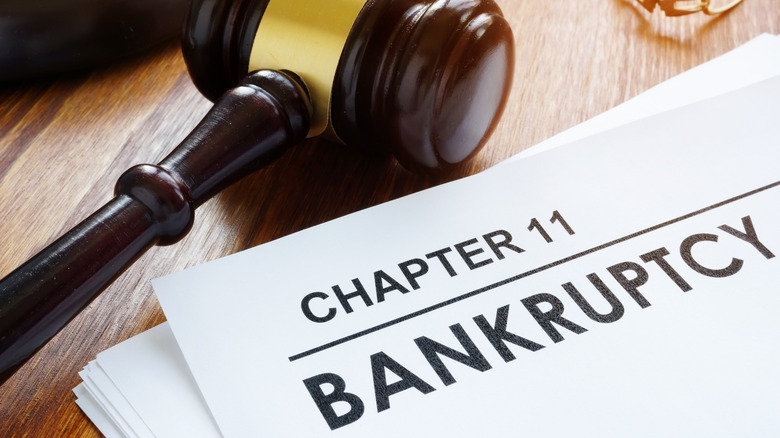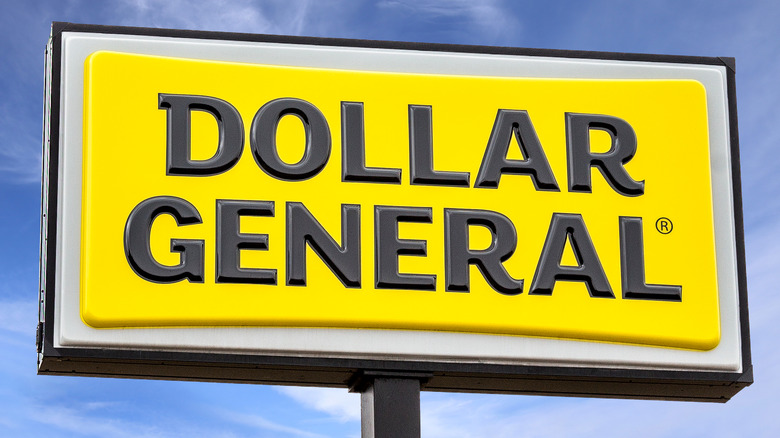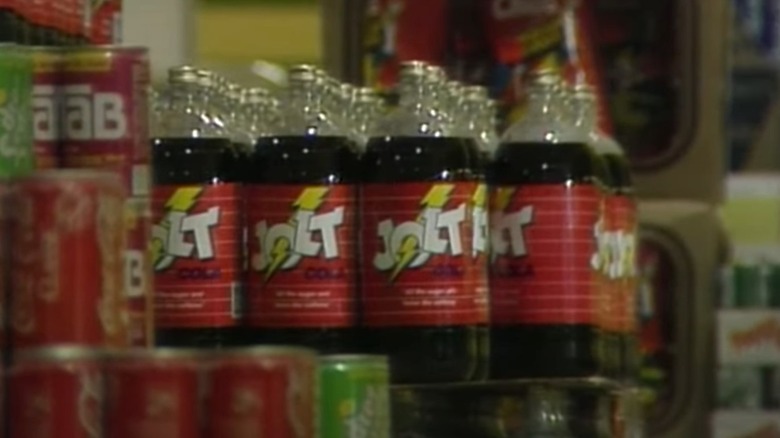The Untold Truth Of Jolt Cola
"All the sugar and twice the caffeine," promised the slogan for Jolt Cola, and it's safe to say it delivered on that declaration. Introduced with the product in 1985 (via Rochester Business Journal), the tagline for the now-extinct soda was perched on every bottle and can, just below its memorable lightning bolt logo.
Of course, shining a spotlight on the astronomical amount of sugar and caffeine contained in every serving of Jolt was certainly a choice — but one that contributed to the soda's distinct appeal during its peak in the late '80s and early '90s. Being an anomaly ensured Jolt Cola stood out from the crowd and allowed it to become more than just a nostalgic footnote of a bygone era, like Surge or Life Savers soda.
Whether you lived through its heyday or not, there's little doubt this flash-in-the-pan beverage — which was ahead of its time in many ways — left a mark on both Gen X-ers and millennials. So let's take a closer look at this teeth-rotting, pulse-pounding beverage and examine the untold truth of Jolt Cola.
The creators aimed to shake up a stale soda industry
It's hard to deny that finding professional or personal success at a younger age — "before the world has done its dirty job," as Janis Ian once sang — only increases whatever self-convictions a person possesses. Even without tangible achievements, youth often breeds brash confidence, and having co-created Jolt Cola at the age of 27 (with his father, Joseph), C.J. Rapp was overflowing with self-assurance as he repeatedly stated his mission in Jolt's conception: to shock a stagnant soda industry.
Frankly, Rapp wasn't shy about his thought process leading to Jolt Cola's development. In 1987, he stated to the Los Angeles Times that soft drinks "are supposed to be refreshing and lots of fun." And, with Jolt Cola, consumers could harken back to the "soda-parlor era," he suggested to People in 1986, bringing a level of sweet, sugar-saturated delight unmatched by the diet and caffeine-free sodas being introduced at the time.
A product some found "naughty and bold," as Rapp described in 1986 to the Chicago Tribune – of which he was quick to note, "we don't mind that image" – it seems fair to say his mission was more than accomplished.
Jolt Cola was considered a treat to enjoy in moderation
Not unlike the way some view variety as the spice of life, moderation is considered the key to happiness by many people. Too much of a good thing can turn even the most ardent fan against a product in the long run, and there's something to be said for avoiding the temptation to overindulge in your favorite foods or drinks — a thought process shared by C.J. Rapp. So, unlike those energy drinks that followed the trail blazed by Jolt Cola, Rapp didn't design the soda for daily consumption, but rather as an occasional "treat," just like "ice cream or candy" (via Chicago Tribune).
As Rapp told The New York Times in 1986, he believed "soft drinks were created for sheer enjoyment and pleasure." With this in mind, he marketed Jolt Cola the way he felt soda was meant to be promoted (via People), as an occasional luxury that could transport consumers to a simpler time.
Did any fans of Jolt Cola heed the founder's advice and limit their intake to special occasions? Well, since obesity increased in the U.S. "from 12% in 1991 to 17.9% in 1998," according to the CDC, it seems unlikely.
1980s health trends led to its creation
It's no secret the keys to a long, healthy life are proper nutrition and consistent exercise — that and finding yourself the beneficiary of any number of lucky breaks along the way. But since it's human nature to rebel against authority, even if it's detrimental to our overall well-being, it's no surprise that Jolt Cola was largely conceived in direct defiance of the health trends that dominated the 1980s (via Chicago Tribune).
"Soft drinks were not intended to be health foods," C.J. Rapp said to the Los Angeles Times in 1987. Considering its tagline highlighted a fully-loaded sugar experience, it's clear Jolt Cola lived up to that idea. The choice to make Jolt an appealing cola alternative to Coke or Pepsi — one that offered a better bang for your buck caffeine-wise — also increased its chances of making an impact on the market.
Colas made up "the biggest portion of the soft drink market" in the U.S. at the time, as noted to South Florida Sun Sentinel by Charles Davison of Beverage Canners (one of Jolt's initial distributors) in 1986. While he conceded it wouldn't appeal to "the very health-conscious consumer," it was also obvious that Jolt had no interest in courting that demographic.
It was one of the first energy drinks
It may not have been marketed or advertised as what we've come to identify as an energy drink, but just because Jolt Cola was technically a cola-flavored soda — rather than an indistinctly-flavored carbonated beverage such as Red Bull – doesn't negate the fact that it was one of the first real energy drinks mass-marketed in the U.S.
C.J. Rapp, the co-creator of Jolt along with his father, Joseph, stated in 1987 that he felt consumers were "looking for ... a replacement of energy" compared to other beverages. Of course, while Jolt Cola's caffeine level was seen as extreme at the time, nearly four decades later, it's almost quaint in comparison to modern energy drinks. After all, a 12-ounce can of Jolt Cola contained 71 milligrams of caffeine (via Los Angeles Times), while an 8.4-ounce can of Red Bull contains 80 milligrams as of 2022.
Jolt Cola deserves credit for planting the initial energy drink seeds in the U.S., but it wasn't the first energy drink in existence. Energy drinks can actually be traced back to Japan in 1962, according to The New York Times, when the Japanese company Taisho released Lipovitan D.
Many expected it to be little more than a novelty
Many products and businesses enter the world with little chance of breaking into, or remaining in, the mainstream. This may be more true in the food and restaurant industry than any other, where for every Outback Steakhouse, there's a dozen Ground Round-types that have faded into obscurity. Indeed, many predicted Jolt Cola would face a similar fate, flaming out as nothing more than a novelty akin to Coke with Lime — which may be best remembered for the silly commercial reworking the Harry Nilsson song "Coconut."
In the eyes of naysayers, the chances of Jolt Cola becoming a nationally-sold brand were slim to none. Then-senior editor of Beverage World, Bob Smith predicted in 1986 that it wouldn't advance beyond "a well-known regional brand." That same year, Jesse Meyers of National Beverage Digest suggested to the South Florida Sun Sentinel that many would subscribe to the belief that "in some lives, one Jolt is enough."
It may not have been long for this world in the grand scheme, going bankrupt in 2009 before a brief revival in 2017 (via PR Newswire). But for a beverage many expected to crash and burn within moments of launch, it did pretty well for itself.
One of the inventors was a veteran of the soda industry
Nepotism can be a blessing and a curse — or just a blessing, we suppose, if you're not ashamed of using your personal connections to your advantage. It's unknown just how C.J. Rapp felt about utilizing the success of his father, Joseph, as a stepping stone to boost the initial profile of Jolt Cola, but in the grand scheme? It probably doesn't matter.
Joseph had operated a soda bottling plant in Rochester, New York for years before assisting his son with Jolt Cola's creation, as noted by The New York Times. His position provided the father-and-son duo a unique window and insight into the soda industry, leading them to conclude the trend toward healthier beverages was unappealing to many consumers.
The two decided to head "in the complete opposite direction," as C.J. told The New York Times in 1986, believing their best opportunity to break into the crowded soda field was simply "to offer a good, hearty, rich cola." And since Jolt remained on shelves nationwide for nearly three decades, it seems their inclinations were proven right.
The soda had a brief run in the pop culture spotlight
When we say Jolt Cola made an undeniable impact on U.S. culture, we're not just making grandiose statements for the heck of it. Frankly, the very fact that a demand exists for this sort of examination of a discontinued soda demonstrates the imprint left by the full-sugar, double-caffeinated beverage — something largely made possible by Jolt's numerous pop culture appearances and parodies into the 1990s.
The promotional efforts made to push Jolt upon its launch are well-known, and they included David Letterman drinking the soda on air and proclaiming, "Wow!" (via People). But the cola's 15 minutes of fame weren't restricted to a one-time shot on "The Late Show." Having gained a reputation as a delectable liquid fuel for non-coffee drinkers, Jolt Cola was seen in several films during the '90s — perhaps most memorably as the drink of choice for "Jurassic Park" villain Dennis Nedry (Wayne Knight) when he bickers with John Hammond (Richard Attenborough).
Additionally, Jolt Cola was seen in a fictional commercial in the film "Hackers," and was parodied in several popular shows, including Buzz Cola on "The Simpsons" and Volt Cola on "Beavis and Butt-Head." There's no doubt these high-profile spots helped lengthen the product's time on shelves and in people's minds. Because if the only memory the world had of Jolt Cola was its flavor profile and logo, who knows how well it would've stood the test of time?
People who disliked coffee enjoyed the alternative
Some folks simply aren't fans of coffee. While this may verge on sacrilegious for some — we're raising our hands — it's entirely fair that each individual possesses their own taste preferences. Luckily, with at least 15 different energy drink brands on the market as of 2022, it's easy to obtain your caffeine fix sans coffee first thing every morning. But when Jolt Cola first appeared on the market in the mid-80s, there was little out there besides tea for those averse to coffee.
It seems reasonable to assume some people have chosen caffeinated sodas over coffee in the morning since their introduction. Yet, as Coke mentions on its website, a 12-ounce can of Coke contains roughly a quarter of the caffeine in a 12-ounce cup of coffee. Jolt may have still come up short to coffee in a direct match-up (via The New York Times), but with "twice the caffeine" of Coke or Pepsi, it offered a far better choice for morning consumers.
Jolt Cola's initial success didn't go unnoticed by the pair of soda titans. By 1989, 10% of all soda was consumed in the morning, spurring a "Coca-Cola in the morning" ad campaign by Coke, as well as the creation of the ill-fated Pepsi A.M. by Pepsi-Cola (via Los Angeles Times).
The caffeine content was just under the legally allowed limit
Since Jolt proudly boasted about containing "twice the caffeine" as other sodas, its release was guaranteed to cause some in the world to take notice with extreme prejudice. But just because C.J. Rapp was once nominated for the alleged "nutrition hall of shame" (via The New York Times) doesn't mean he or his product broke any laws or regulations with its caffeine content.
In fact, Jolt Cola contained 5.9 milligrams of caffeine per fluid ounce, which was just below the FDA's maximum allowable amount of 6 milligrams. While some found it "reprehensible that so much caffeine could be added to a product that's used primarily by kids," as Michael Jacobson of the Center for Science in the Public Interest said to New York Magazine in 1986, the bottom line was the soda was only breaking taboos, not laws.
And, as the company was quick to point out, the FDA's "caffeine maximum for coffee [was] five times the amount of caffeine in Jolt" (via Chicago Tribune). In other words, while the claims of unhealthiness weren't untrue — given the high dose of added sugar — those who directed their ire at the caffeine level may have been misguided.
Jolt highlighted the fact it was made from real sugar
It's safe to say Jolt Cola was largely conceived as a way for the product's creators to thumb their nose at the health trends of the 1980s. But in another way, it's fair to say the company embraced the so-called clear craze of the era — in which products seen as clear or pure were actively promoted, like Crystal Pepsi — with the marketing decision to highlight its use of real sugar rather than high fructose corn syrup (via South Florida Sun Sentinel).
Jolt's choice to lean into its natural sugar usage — in lieu of using a cheap, lab-created knockoff in its product (via People) — wasn't some sort of revelation within the food industry, but it didn't matter. What mattered was that the ploy worked and, along with its decision to shun high fructose corn syrup in the first place, provided another example of Jolt Cola being ahead of the curve.
There may not be anything new or illuminating about a company like Jolt choosing to promote its product as natural or minimally processed, but, quite frankly, it's amusing to consider anything about Jolt Cola as pure or natural.
Jolt filed for bankruptcy in 2009
In 2009, more than two decades after its initial introduction, Jolt Cola filed for bankruptcy (via Reuters) — though you'd be hard-pressed to find a single person shocked by that news. After all, Jolt Cola's ability to defy the odds — and not go under within three to five years, as several Jolt bottlers expected (via South Florida Sun Sentinel) — could realistically be attributed to its status as a once-rare substitute for coffee.
But as the energy drink market became more and more saturated as the 2000s went along, Jolt had to do something to keep up with the competition. Unfortunately, these efforts led to a deal with the company Rexam to produce resealable "battery bottles" — a poorly-conceived agreement that left Jolt unable to pay for the agreed-upon number of cans (via Rochester Business Journal). Combined with the recession and poor sales, the high cost of the battery bottles doomed Jolt, which couldn't fulfill its end of the deal, leading it to file for Chapter 11.
Maybe the demise of Jolt Cola was inevitable, particularly once Red Bull, Monster, and a number of energy drinks hit U.S. markets. After all, how could Jolt compete when, as noted in a 2013 study (published in the Journal of Caffeine Research), the FDA has no legally imposed limits on caffeine content for energy drinks — but does restrict how much caffeine a soda can contain.
The soda returned briefly as a Dollar General exclusive in 2017
Given the insatiable need to revive any and all things from the '80s and '90s, it may have only been a matter of time before Jolt Cola reappeared on store shelves after its bankruptcy in 2009. So, like "DuckTales" before it, Jolt Cola was resuscitated from the grave in 2017, when it was brought back to the market as a soda sold exclusively at Dollar General (via PR Newswire).
How Jolt Cola returned to U.S. shelves, as an item only found in Dollar General stores, resulted from "a chance meeting on a plane," according to Jolt Cola spokesperson Kathryn Lyons. After Dollar General and Jolt executives discussed the "brand alignment and market potential" of a collaboration mid-flight, the two companies struck a one-year deal to return Jolt Cola to U.S. consumers.
The chance to once again taste their childhood was certainly enticing to customers, as was the $1 price point.
It appears to have been discontinued by 2020
It's sort of obvious why a company would choose to advertise its successes while minimizing its failures. After all, who wants to revel in a poor performance, or luxuriate in misery when reflecting on those times you fall flat? Frankly, given that, it's easy to ascertain why companies often withhold information regarding the precise date and time a product is discontinued — which may explain why the date of Jolt Cola's (second) demise is difficult to pin down.
If nothing else, the soda appears to have been off the market and out of stores by 2020, according to Reddit users. But there's a strong likelihood Jolt Cola was actually discontinued before the end of the 2010s, since the company's official Twitter account last tweeted on March 29, 2019. Now, we certainly don't mean to imply Twitter is the be-all and end-all in our modern world, but it's never a good sign when a company's official social media account goes silent.
Will the world ever again have the chance to experience the sugar-soaked, energy-inducing beverage in the future? Only time will tell — though there's always eBay for those undeterred by the prospect of drinking years-old soda.
